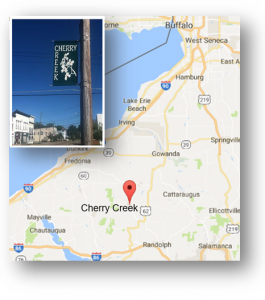
 Just over a week ago, the tranquil Village of Cherry Creek voted, by a 2-1 margin, to dissolve. Located about 20 miles northeast of Jamestown in Chautauqua County, the village was formed in 1893 to offer residents more “urban” services than were offered in the town, now including street lights, water, sewer and sidewalks. In 1900 the village was home to 700 with another 1,000 in the Town of Cherry Creek outside the village. It was a self-contained community with a successful cannery, foundry, and flour mill plus a business district with a bank, hotels, churches and other establishments. Nearly everyone who lived in Cherry Creek, worked in Cherry Creek.
Just over a week ago, the tranquil Village of Cherry Creek voted, by a 2-1 margin, to dissolve. Located about 20 miles northeast of Jamestown in Chautauqua County, the village was formed in 1893 to offer residents more “urban” services than were offered in the town, now including street lights, water, sewer and sidewalks. In 1900 the village was home to 700 with another 1,000 in the Town of Cherry Creek outside the village. It was a self-contained community with a successful cannery, foundry, and flour mill plus a business district with a bank, hotels, churches and other establishments. Nearly everyone who lived in Cherry Creek, worked in Cherry Creek.
The population of the town fell to about 1,200 by 1930 and has remained stable since, although the village population is now below 500. Other changes have caught up with Cherry Creek, however. The cannery, foundry and mill are long gone. A few retailers remain, but the village center is pretty quiet. Most of the residents work in Jamestown, Fredonia, Erie or Buffalo. The Village Board continues to faithfully do the work of the community, although members acknowledge that elections lack suspense. “Why don’t you run?” a longstanding member asked a fellow resident. “Just don’t have time,” was the reply. “And you’re doing a great job.” Consider a family with two earners, both traveling outside Cherry Creek to work—busy lives leave little time for civic service.
The village and town already share services. Both rely on the Chautauqua County Sheriff for public safety. The fire company serves both. Street maintenance and plowing are performed by the Town Highway Superintendent. The only costly services run by the village are the water and sewer systems, services the town doesn’t offer. Once dissolved, these will be managed by the town, although the cost will be borne by the users through fees, just like now. Although other efficiencies are likely to emerge over time, the immediate savings will be the very modest $8,000 paid to the Village Board and the Mayor.
As consultant to the village in this process (see our report), I was asked in private how I would vote. I demurred, partly from a professional obligation to neutrality, but also from a conviction that the village would be OK either way. It was already wisely sharing costly services with the town and county—so the out-of-pocket cost of retaining the village is small. But the risk of dissolving is also small—the town is well run and its leaders are willing to assume new responsibilities. The “special district” allowed in law permits the town to continue village services without imposing the cost on all town taxpayers.
The voters decided that it was time. After all, they will still live in “Cherry Creek” and will still have a voice in local government. Village voters are also town voters in New York state—village government is a kind of overlay. It doesn’t displace the town, as does a city government. Voters from the soon-to-be former village control two-fifths of the town votes. With only positions on the Town Board to fill instead of two, it may be easier to find candidates to run.
Another advantage to dissolving is the state’s Citizens Empowerment Tax Credit. NYS offers a sizeable incentive for local governments to merge. The Town of Cherry Creek will receive 15% of the combined property tax levy of the town and village every year—in Cherry Creek this comes to $96,000. Add the $8,000 and this totals a fifth of the town’s current tax levy. This may have tipped the balance with Cherry Creek voters.
Small needn’t be inefficient. Cooperation among rural governments is ubiquitous in Chautauqua County (supported by the county’s Regional Solutions Commission) and routine throughout the state. Public safety and public works are most of the tax levy—when these are shared with other local governments, the cost of what remains is no more than a rounding error in what we pay in school taxes (which is what the most of our property tax supports).
It is in urban and suburban communities that merger can yield true savings. An Irondequoit resident, I find our 5 fire companies hard to justify. They contribute mightily to the 4th of July parade, but most of those pretty trucks are rarely used. And there’s the Seabreeze Water District, which is surely redundant.
Police consolidation in Monroe County was soundly rejected by the voters in 1983, falling victim to parochialism and a stew of race anxiety. Rochester, Greece, Irondequoit, Brighton, Gates, Ogden, Webster and the villages of Brockport, Fairport and East Rochester have independent police departments. The rest—Penfield, Pittsford, Mendon, Chili etc—rely on the Sheriff’s Department. This isn’t only inefficient, it is also inequitable. My town tax pays for the Irondequoit force and my county tax pays for the Sheriff’s road patrol—in Pittsford.
Governor Cuomo’s push to improve government efficiency is well intentioned, although his focus on eliminating specific units of government, e.g. villages, may be misdirected. Villages play an important role in many regions of the state. Instead of eliminating them, we might better focus on re-defining the powers of a village once its population has dipped below, say, 500.
An expanded application of town-controlled special districts would also be appropriate. Many village dissolutions fail because towns are not empowered to create police districts. These would permit towns to provide police protection in urban clusters without burdening all town residents with the cost.

The Village of Malone in Franklin County is a case in point—as Franklin County has no sheriff’s road patrol, the elimination of village police would leave the residents relying solely on the State Police.
I applaud the diligence of local public officials like those in Cherry Creek. Effective local services—from holiday lighting to local zoning to sewers—are key to maintaining the high quality of life most of us enjoy in the State of New York.